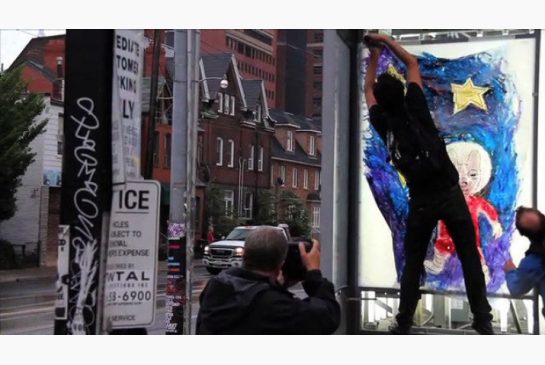
Activists removed ads Sunday, Aug. 22, 2010, throughout downtown Toronto and replace them with pieces of art.
A lanky, 6-foot-tall New Yorker dressed in black, maneuvers through Toronto armed with an electric screwdriver, duct tape, a stepladder, and a doorknob. His target: A four-sided, Pattison ad pillar.
He removes a screw; inserts the doorknob and cranks open the frame as nearby sirens sound. Within minutes, he is gone, having replaced the ads with art.
One down, 41 to go.
His name is Jordan Seiler, the founder of the Public Ad Campaign, an initiative committed to reclaiming public space from what the campaign contends are illegal advertisers, and filling it with guerilla art.
On Sunday afternoon, Seiler led 15 activists into a war against Canadian billboard giant Pattison Outdoor by removing ads from 41 pillars and replacing them with 85 pieces of art.
“Public space should be a place for public communication,” said the 30-year-old. “I feel like I have a right to react against (advertisements) when, in particular, they’re done illegally.”
The Star was unable to confirm the legal status of the signs targeted by the group, and efforts to reach Pattison Outdoor for comment Sunday were not successful.
Dubbed the Toronto Street Advertising Takeover, TOSAT for short, six ground-level teams of two to three piled into four rental cars Sunday afternoon.
Around 5 p.m., the group left the ‘safehouse’ near Casa Loma with art submitted from around the world including Spain, Berlin, California and Canada.
According to local activist and co-organizer Vanessa Moraless, the action was prompted by what the group argues is Pattison’s non-compliance with Toronto’s billboard laws.
Last December, the city passed a billboard tax ranging from $850.68 to $24,000, which would contribute $10 million to city coffers.
On April 6, 2010, the new sign bylaw and tax went into effect — to the relief of anti-advertising advocates and to the dismay of billboard companies like Pattison, which filed an action against the city with the Ontario Superior Court of Justice to contest the law.
Local activists are concerned that the city is still being too lax with the enforcement of bylaws.
“Pattison built them without permits mostly in the middle of the night,” contends Rami Tabello, coordinator of IllegalSigns.ca.
Tabello has spent the past four years filing Freedom of Information requests to track down unauthorized ads for his website while working with the city to remove them.
He estimates around 30-40 Pattison pillars in the GTA are illegal, but added that he had no connection with Sunday’s guerilla action.
“My organization is not related to TOSAT. Our motto is ‘We fight illegal billboards with the rule of law.’ The rule of law, unfortunately, is not quite working at the moment,” he said.
When contacted Sunday evening, city councillor Adam Vaughan (Ward 20, Trinity-Spadina) expressed disapproval of the action, but noted that the city was on top of the issue.
“I can certainly recognize the frustration that the illegal billboards haven’t all been taken down, but it’s a big city and we’re getting to it,” he said.
Seiler’s installations went down Bathurst St., and seven of the Pattison Pillars he targeted are located inside Vaughan’s Ward 20.
An enforcement team for illegal billboards is currently being assembled, Vaughan added.
“The Pattison Pillars . . . were a hangover from a previous councillor,” Vaughan said. “It’s not clear as to how they were approved.
“I know its in contention with a lot of billboard activists but we’re trying to deal with it with the bylaw,” the councillor noted. “We should have an answer for those people who are concerned there are too many of them very shortly.”
Seiler finished his installations around 7 p.m. Sunday as teams around the city were also wrapping up.
Pedestrians marveled at the pieces of artwork and at times, engaged with Seiler and other installers.
“It’s a mental leap that most people don’t have a chance to engage in,” said Seiler. Ads, he added, “are improper mental stimulation. The idea that we feel like we don’t have ownership (of public space) becomes problematic.
“If these projects prove that we do have ownership, it also questions whether or not there’s a force preventing us access to that,” Seiler said.










Join In On The Conversation!
You must be logged in to post a comment.